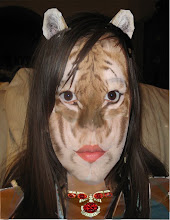The Grey Wolf (Canis Lupus), also known as just; the wolf, are dominant predators and the largest of canines. In size, wolves resemble a German Shepard, or a Husky, though they are larger still. There are many subspecies of grey wolf, though the exact number is up for debate. At one point, wolves lived in most of the northern regions of Europe, Asia, and North America, but that territory has become increasingly smaller for various reasons.
Wolves are very tough animals, as the inmabit many biomes. There paws are large, and have a slight webbing between each clawed toe, to enable the predator to move more agilely than the prey they hunt. Wolves also have two layers of their pelt, though the undercoat is shed in the hotter months. The undercoat is an insulator, that is water resistant, and the overcoat keeps dirt and wind from the animals body. Wolves pelts have a wide range of colors; red-browns, browns, whites, greys, blacks, and grey-browns. Usually there is a mix of two or more colors (greys/grey browns with white is relatively common), though a one-color pelt is not uncommon. Single-color furs are usually all white or all black. The fur is lighter on the belly for two-tones or multi-tones.
Wolves often live in packs led by an Alpha, though loners are not nonexistent. Lone wolves commonly were driven from there pack by the alpha, usually after some sort of wrongdoing. Packs usually consist of an alpha, there mate, their pups, the hunters, and their pups. Wolves are very territorial, though loners are occasionally accepted in to a pack. Wolves are carnivores, feeding mainly on deer, moose, elk and other large prey.
Wolves do not bark. They snarl, growl and howl for various reasons, though despite popular belief that wolves "howl at the moon", is urban myth. Wolves howls can be heard more clearly at night due to the fact that there is less sound at night. Howling is a means of long distance communication.
Wolves and dogs are close enough in gene code to produce fertile and healthy offspring, and though uncommon, matings between wild wolves and domesticated dogs has occurred. Wolfdogs are less open to genetic diseases than most dogs. The German Shepard species is actually the result of breeding a wolf and a dog, then a wolfdog and a dog, and so on. Coywolves (a cross between a coyote and a wolf), are possible. The smaller
Wolf Subspecies include:
- The Artic Wolf, (canis lupus arctos)
- The Tundra Wolf or Eurasian Artic , (canis lupus albus)
- The Arabian Wolf, (canis lupus arabs)
- The Mexican Wolf, (canis lupus baileyi)
- The Russian Wolf, (canis lupus communis)
- The Italian Wolf, (canis lupus italicus)
- The Egyptian Wolf, (canis lupus lupaster)
- The Eurasian Wolf, (canis lupus lupus)
- The Eastern Wolf, (canis lupus lycoan)
- The Great Plains Wolf, (canis lupus nubilus)
- The Northwestern Wolf, (canis lupus occidentalis)
- The Indian Wolf, (canis lupus pallipes)
- The Iberian Wolf (Canis lupus signatus)
- The Ethiopian Wolf (Canis simensis)
This post is dedicated to my "summer sister" Timbra Wolf
A big thanks to:
http://wikipedia.org/wiki/wolf
AND
http://www.caninest.com/types-of-wolf/
